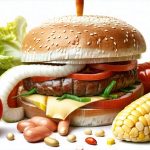The modern Western diet, characterized by highly processed foods, refined sugars, and limited fiber, has profoundly impacted not just our overall health but also the intricate ecosystem within us – the gut microbiome. This vast community of trillions of microorganisms residing in our digestive tract plays a crucial role in everything from digestion and immunity to mental wellbeing. A diet dominated by processed foods often leads to a dysbiotic microbiome—an imbalance favoring harmful bacteria—contributing to inflammation, compromised immune function, and an increased risk of chronic diseases. Transitioning from processed to a whole-food based diet isn’t simply about eliminating “bad” foods; it’s about actively nurturing the beneficial microbes that support our health and vitality. It’s a shift towards feeding ourselves and our inner ecosystem.
Many people attempt drastic dietary changes with ambitious plans, only to find themselves overwhelmed and reverting back to old habits. This is where understanding the microbiome comes in. A successful transition isn’t about deprivation or restrictive rules; it’s about gradually incorporating more whole foods while simultaneously fostering a thriving microbial community that will actually crave these nourishing options. It’s a process of retraining your palate, rebuilding gut health, and establishing sustainable habits for long-term wellbeing. This article will explore microbiome-friendly strategies to navigate this transition smoothly, focusing on practical steps you can take to support both yourself and the microscopic life within. If you experience issues along the way, learning how to manage indigestion can be helpful.
The Gradual Shift: A Phased Approach
Abrupt dietary changes are often unsustainable because they create strong cravings and feelings of deprivation. Instead, think of it as a phased approach, building upon small, achievable steps. Start by identifying the most problematic processed foods in your diet – those you consume frequently and offer little nutritional value. These might include sugary drinks, packaged snacks, fast food, or refined grain products. Don’t aim to eliminate them all at once. Focus on replacing one item at a time with a whole-food alternative. For example, swap soda for sparkling water infused with fruit, or potato chips for a handful of nuts and seeds. This strategy minimizes shock to your system and allows your microbiome to adapt gradually.
This phased approach also applies to introducing new foods. Suddenly increasing fiber intake can cause digestive discomfort, which is counterproductive. Begin by adding small amounts of fiber-rich foods like berries, leafy greens, or legumes to your diet and slowly increase the quantity over time as your gut bacteria adjust. This allows them to develop the enzymes needed to efficiently digest these foods, minimizing bloating and gas. Remember that diversity is key – a wide range of plant-based foods supports a diverse microbiome, which is associated with better health outcomes. Learning how to rotate foods can also help avoid sensitivities and fatigue.
The goal isn’t perfection; it’s progress. Allow yourself occasional indulgences without guilt or self-criticism. Viewing healthy eating as a rigid set of rules can lead to stress and ultimately sabotage your efforts. Instead, focus on making conscious choices the majority of the time, celebrating small victories, and viewing setbacks as learning opportunities. A sustainable lifestyle change is built upon consistency rather than restriction. If you slip up, knowing ways to recover from a trigger meal can lessen the impact.
Cultivating a Thriving Gut: Prebiotics & Probiotics
Beyond simply reducing processed foods, actively supporting your gut microbiome through prebiotics and probiotics can significantly enhance the transition process. Probiotics are live microorganisms found in fermented foods like yogurt, kefir, sauerkraut, kimchi, and kombucha. These beneficial bacteria directly contribute to the diversity of your gut flora. Incorporating small servings of these foods into your diet can help repopulate your gut with healthy microbes. However, it’s important to note that probiotic supplements aren’t always necessary or even effective for everyone; food sources are often preferred as they come packaged with other beneficial compounds.
Prebiotics, on the other hand, are types of fiber that serve as food for your existing gut bacteria. These are found in abundance in foods like onions, garlic, leeks, asparagus, bananas, oats, and apples. By feeding your good bacteria, you encourage their growth and activity, strengthening your microbiome’s overall health. Combining probiotic-rich foods with prebiotic-rich foods creates a synbiotic effect—a synergistic relationship that maximizes the benefits for your gut. Understanding what to expect when cutting trigger foods can help you stay on track.
Consider incorporating fermented foods gradually to avoid digestive upset. Start with small amounts and observe how your body responds. If you have underlying digestive issues, consulting with a healthcare professional is advisable before significantly increasing probiotic intake. Remember that everyone’s microbiome is unique, so finding what works best for you is essential.
Fermentation Fundamentals: DIY & Store-Bought Options
Fermenting foods at home can be a rewarding and cost-effective way to increase your probiotic intake. Simple ferments like sauerkraut or kimchi are relatively easy to make with just a few ingredients – cabbage, salt, and time. There are countless online resources and tutorials available to guide you through the process. Not only does fermentation preserve food, but it also enhances its nutritional value and creates unique flavors. However, proper sanitation is crucial to avoid contamination during home fermentation.
If you prefer store-bought options, look for products that specifically state “live and active cultures” on the label. Be mindful of added sugars or preservatives, as these can negate some of the health benefits. Also, pasteurized fermented foods have had their beneficial bacteria killed off during processing, so choose unpasteurized varieties whenever possible. Experiment with different types of fermented foods to find those you enjoy and incorporate them regularly into your meals.
Fiber Focus: Beyond Just Adding More
While increasing fiber intake is vital for a healthy microbiome, it’s not just about quantity; quality matters too. Different types of fiber feed different bacteria, contributing to overall microbial diversity. Soluble fiber, found in foods like oats, beans, and apples, dissolves in water and forms a gel-like substance that slows digestion and helps regulate blood sugar levels. Insoluble fiber, present in whole grains, vegetables, and fruits with edible skins, adds bulk to stool and promotes regularity.
Focus on incorporating a variety of fiber sources into your diet rather than relying solely on one or two. Experiment with different types of beans, lentils, whole grains, fruits, and vegetables to ensure you’re providing a diverse range of nutrients for your gut bacteria. Also, remember that cooking methods can affect fiber content – steaming or lightly sautéing vegetables preserves more fiber than boiling.
Hydration & Gut Health: The Often-Overlooked Link
Adequate hydration is essential for optimal digestion and microbiome function. Water helps move food through the digestive tract, preventing constipation and promoting regularity. It also supports the growth of beneficial bacteria by providing a favorable environment for them to thrive. Dehydration can lead to reduced microbial diversity and increased inflammation.
Aim to drink at least eight glasses of water per day, adjusting based on your activity level and climate. Herbal teas and infused waters are great alternatives to plain water if you struggle to stay hydrated. Pay attention to your body’s signals – thirst is a late indicator of dehydration, so sip water throughout the day even when you don’t feel thirsty. Consider that certain foods with high water content, like cucumbers and watermelon, can also contribute to your daily fluid intake.
Transitioning to a whole-food diet isn’t just about changing what you eat; it’s about cultivating a mindful relationship with food and recognizing the interconnectedness between our bodies and the microscopic world within us. By embracing a phased approach, prioritizing prebiotic and probiotic rich foods, focusing on fiber diversity, and staying adequately hydrated, we can nurture a thriving microbiome and unlock the path to lasting health and wellbeing.


















